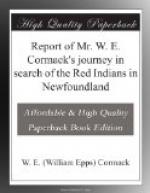My party consisted of three Indians, whom I procured from among the other different tribes, viz. an intelligent and able man of the Abenakie tribe, from Canada; an elderly Mountaineer from Labrador; and an adventurous young Micmack, a native of this island, together with myself. It was difficult to obtain men fit for the purpose, and the trouble attending on this prevented my entering on the expedition a month earlier in the season. It was my intention to have commenced our search at White Bay, which is nearer the northern extremity of the island than where we did, and to have travelled southward; but the weather not permitting to carry my party thither by water, after several days delay, I unwillingly changed my line of route.
On the 31st of October 1828 [Sic: 30th of October 1827] last, we entered the country at the mouth of the River Exploits, on the north side, at what is called the Northern Arm. We took a north-westerly direction to lead us to Hall’s Bay, which place we reached through an almost uninterrupted forest, over a hilly country, in eight days. This tract comprehends the country interior from New Bay, Badger Bay, Seal Bay, &c.; these being minor bays, included in Green or Notre Dame Bay, at the north-east part of the island, and well known to have been always heretofore the summer residence of the Red Indians.
On the fourth day after our departure, at the east end of Badger Bay-Great Lake, at a portage known by the name of the Indian Path, we found traces made by the Red Indians, evidently in the spring or summer of the preceding year. Their party had had two canoes; and here was a canoe-rest, on which the daubs of red-ochre, and the roots of trees used to fasten or tie it together appeared fresh. A canoe-rest is simply a few beams, supported horizontally, about five feet from the ground, by perpendicular posts. A party with two canoes, when descending from the interior to the sea-coast, through such a part of the country as this, where there are troublesome portages, leave one canoe resting, bottom up, on this kind of frame, to protect it from injury by the weather, until their return. Among other things which lay strewed about here, were a spear-shaft, eight feet in length, recently made and ochred; parts of old canoes, fragments of their skin-dresses, &c. For some distance around, the trunks of many of the birch, and of that species of spruce pine called here the Var (Pinus balsamifera), had been rinded; these people using the inner part of the bark of that kind of tree for food. Some of the cuts in the trees with the axe were evidently made the preceding year. Besides these, we were elated by other encouraging signs. The traces left by the Red Indians are so peculiar, that we were confident those we saw here were made by them.




